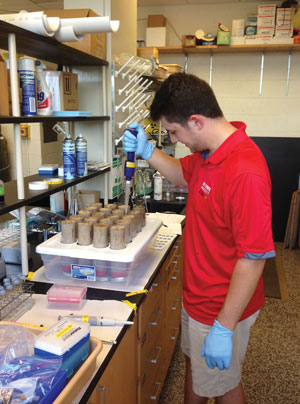
The affinity that many fungicides have for soil particles and organic matter plus the dense foliage and thatch layer in turfgrass systems make delivery of fungicides to the root zone difficult and management of crown and root diseases of turf a challenge.
A lab experiment was conducted in Raleigh, N.C., to determine whether soil surfactants can increase fungicide distribution — and thereby improve fungicide efficacy — in soil.
Sand-coated lysimeters were packed with 90% sand/10% peat (v/v) constructed according to USGA guidelines to a bulk density of 0.80 ounce/cubic inch (1.4 grams/cubic centimeter). The soil was treated three times at two-week intervals with one of three soil surfactants (Aquifer, Fleet or Revolution) at a rate of 1.36 gallons/acre (12.7 liters/hectare), and irrigated with 0.25 inch (0.6 centimeter) water after each application.
Immediately after the third soil surfactant application, 14C-myclobutanil was applied (1.36 pounds/acre [1,528.8 grams a.i.v/hectare]; 0.74 microcurie/lysimeter) and irrigated with 0.25 inch water. Leachate and soil moisture content were recorded throughout the experiment.
From the non-treated control, < 2% of myclobutanil was recovered below 3 inches (7.6 centimeters). On average, > 2% of 14C-myclobutanil was recovered in the 3- to 4-inch (10.2-centimeter) sampling depth when soil was treated with any of the surfactants. Downward movement of 14C-myclobutanil was greater with surfactant application, and there were no differences among the soil surfactants. After three soil surfactant treatments, more leachate was collected from columns treated with any of the surfactants than from the non-treated control.
— Wendell J. Hutchens; James P. Kerns, Ph.D.; Travis W. Gannon, Ph.D.; and David Shew, Ph.D., North Carolina State University, Raleigh, N.C.
Editor’s note: An earlier version of this summary was published in the 2018 ASA-CSSA Meeting Abstracts, ASA and CSSA, Madison, Wis.
Teresa Carson is GCM’s science editor.